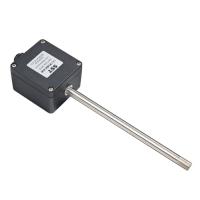The world's fastest battery-powered NDIR CO2 sensor
Gas Sensing Solutions (GSS) Ltd, the LED-based NDIR detector
specialists, continues to push the boundaries for CO2 detectors with the
launch of its new SprintIR6S. GSS' unique SmartIR™technology has
enabled it to create a sensor that can take up to 20 readings per
second, which is a world record for NDIR CO2 detectors, and has a six
times faster response rate than the
SprintIR CO2 sensor*.
Ralph Weir, GSS' CEO, explained, "We are the only company
producing CO2 sensors using LEDs and photodiodes and, as we make the
LEDs and photodiodes ourselves, we have been able to develop ultra-fast
response times that no other
NDIR sensor
can match. Typical NDIR CO2 detectors take several seconds or even
minutes to take a reading - because they use slow-reacting IR sources,
which need time and energy to warm up, like MEMS hotplates, micro-bulbs
or filament-based micro-lamp technologies. Our LEDs, by contrast, are
Solid State emitters, and illuminate almost instantly. With the new
SprintIR6S, we've also minimized the sample volume down to only 2ml,
which enables us to achieve our fastest ever response rates*. This puts
us in a unique position to open whole new application areas for CO2
monitors that could never be addressed by slow responding sensors based
on traditional IR sources."
Applications for this new class of ultra fast CO2 sensors include
health where they can capture rapidly changing CO2 concentrations in the
breathing cycle to provide diagnostic information, which can be used in
fitness testing, breath analysis/measurement, capnography, sports
science and veterinary to name a few. In Industrial Health and Safety
applications, such as factories where CO2 is used for modified
atmospheres to delay packaged food from spoiling, they can provide ultra
fast detection of rising CO2 levels. Even a doubling or tripling of
normal CO2 levels can affect concentration and productivity with higher
levels having increasingly deleterious effects on health right up to
unconsciousness and death.
"A leak from a CO2 canister or similar can push CO2 levels
up from the normal 400ppm to several thousand ppm in seconds,"
added Ralph Weir. "You cannot smell CO2 and it is colorless.
Yet it can present serious health problems at raised concentrations so,
the sooner an alarm is raised, the sooner people can take remedial
action. For example, restaurants and pubs usually have CO2 cylinders in
the basement for the drinks but basements typically have poor
ventilation so an undetected CO2 leak could suddenly raise the CO2 level
when someone was in the basement and render them unconscious - or
dead. Our new sensors can give the earliest possible
warning."
GSS' multi-patented SmartIR™ technology detects the presence of CO2
by detecting how much light is absorbed by CO2 molecules as light passes
through the sample gases - called Non-Dispersive InfraRed (NDIR)
absorption. CO2 absorbs between 4.2 and 4.4 microns so that its
presence is easily detected, and the amount of light absorbed indicates
how much CO2 is present. Typically, CO2 detectors use a miniature heater
(such as MEMS devices like micro hotplates, microlamp/microbulb or
filament heater) to generate a range of wavelengths that have to be
filtered down to the wavelengths needed, which is wasteful and energy
inefficient, especially as a lot of heat is produced. By contrast, GSS
developed the world's first commercial, mid-range IR LEDs that are
specifically tuned to emit just at 4.2 to 4.4 microns, making them
highly energy efficient. As a result, GSS CO2 sensors are the only
NDIR CO2 sensors that can be powered by batteries - a single lithium cell can power a SmartIR sensor for up to ten years.
At less than a cubic inch (23.8mm in diameter and 24mm tall), the
SprintIR6S operates at between 3.25 and 5.5V, with a power consumption
of only 35mW. The SprintIR6S is available in measurement ranges from
0%to 100%.
GSS will be revealing the new SprintIR6S detectors at the Sensor + Test show in Nuremberg, Germany from 30 May to 1 June 2017.
High Speed Carbon Dioxide Sensor NDIR CO2 Sensor SprintIR Summary
SprintIR is a high speed (20 Hz)
CO2 sensor,
ideally suited for applications which require capture of rapidly
changing CO2 concentrations including metabolic assessment and
analytical instrumentation.
Fast, Accurate Carbon Dioxide Sensor
The SprintIR carbon dioxide sensor is the fastest, most accurate CO2
sensor on the market. A breakthrough in NDIR technology, the SprintIR
uses advanced solid state Indium Antimonide LED’s and detectors to
offer a robust sensor with no moving parts, no heated filaments, and
incredibly low power requirements. The sensor comes in four versions -
from 0% to 100% - all capable of the same high-speed CO2 measurement.
This makes the SprintIR especially useful in biological applications.
• High speed sensing (20Hz)
• Measurement ranges from 0 to 100%
• 3.3V supply
• Low power requirement 35mW
• Flow through adaptor (Optional)
High Speed Carbon Dioxide Sensor NDIR CO2 Sensor Specifications
| CO2 Measurement |
| Sensing Method |
Non-dispersive infrared (NDIR) absorption
Patented Gold-plated optics
Patented Solid-state source and detector |
| Sample Method |
Diffusion(Standard) / Flow through (with flow-through adapter) |
| Measurement Range |
0-5%, 0-20%, 0-60%, 0-100% |
| Accuracy |
±70 ppm +/- 5% of reading |
| Measurement Noise |
<10% of reading with no digital filtering |
| Non Linearity |
< 1% of FS |
| Pressure Dependence |
0.1% of reading per mbar in normal atmospheric conditions |
| Operating Pressure Range |
950 mbar to 10 bar |
| General Performance |
| Warm-up Time |
< 1 minute |
| Operating Conditions |
0°C to 50°C (Standard)
-25°C to 55°C (Extended range)
0 to 95%, RH non-condensing |
| Recommended Storage |
-30°C to +70°C |
| Electrical/ Mechanical |
| Power Input |
3.2 to 5V. (3.3V recommended)
Peak current 100mA
Average Current <15mA |
| Power Consumption |
35 mW |
| Output |
UART only |




